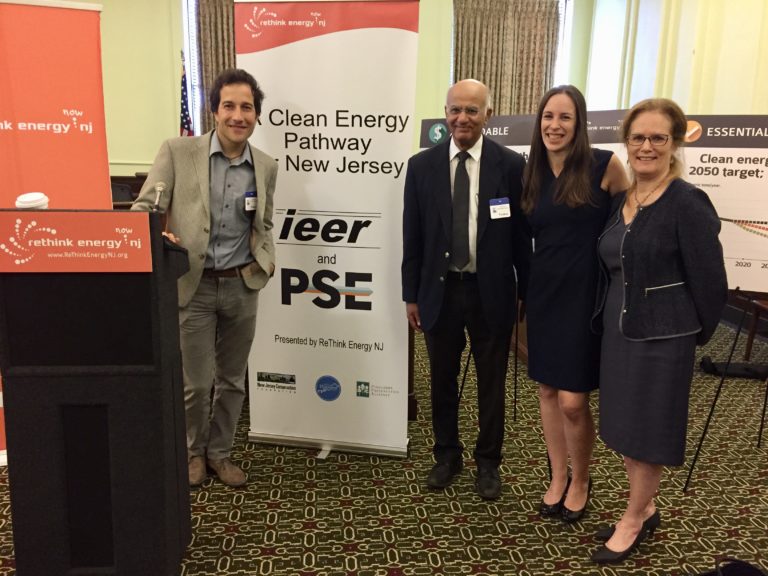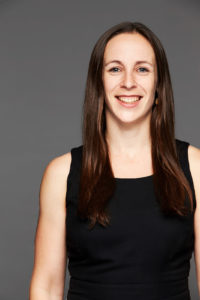
When hydraulic fracturing started to take off in the northeastern U.S. in 2008, data about the impacts to environmental and human health was scarce. In response, local researchers embarked on experimental studies and began to share their findings with each other. These researchers not only sped up the scientific community’s understanding of fracking’s risks and impacts – and increased public awareness – but some also became the founders of a non-profit. Physicians, Scientists, and Engineers for Healthy Energy (PSE) officially started in 2010 at Cornell University. PSE’s team has since expanded to Oakland, California, and its scope has broadened beyond fracking. Today, PSE generates original research on many types of energy production and clean energy transitions with a focus on environmental justice. Elena Krieger is the director of the renewable energy program at PSE. She holds a Ph.D. in mechanical and aerospace engineering and has expertise in energy storage for renewables.
CK: What does PSE aim to do? Krieger: Our objective is to support data-driven and science-driven energy policy. We also aim to empower stakeholders from every background, from community groups to policymakers, to understand how to use science and data to create evidence-based policy. I think what makes us unique, and what we really like doing, is interdisciplinary work that's at the interface of public health and environmental engineering and science.
CK: PSE conducts research in different states across the country. How do you pick research projects?

Elena Krieger
Krieger: We tend to do work in places where we think that science and data are missing and can be useful to drive better policy. I know that sounds very broad but what that means, on a more specific level, can be seen in our projects. For example, we developed a clean energy pathway for the state of New Jersey just before the governorship changed so that we could lay out a technical framework for the transition. We integrated this analysis with constant communication with a range of stakeholders, including both our advisory committee and others across the state. In cases without an existing policy opportunity, if we collect our own data or aggregate existing data we can demonstrate that maybe there should be some kind of additional decision-making on a certain issue, whether that would be setbacks from oil production sites or the incorporation of energy storage into state clean energy targets. People also come to us with questions. I think of a lot of our work as pro bono science consulting. For example, grassroots organizations might not have technical capacity and come to us with questions, and we will help them find the data. We have access to the papers and can do a little bit of legwork for them to answer those questions and inform what they're working on. On the flip side, interesting research ideas come up when we have those conversations. They help us get a sense of what people are worried about, what problems they are facing on the ground, what kind of environmental health problems concern them, and what kind of energy opportunities they are or are not thinking about. That helps shape what kinds of projects we do.
CK: You have three main areas of research: clean energy, energy and environment, environmental health. Can you discuss a recent or ongoing project?
Krieger: I can tell you what I am currently working on. The big picture is that we are trying to figure out how we can put energy storage on the grid to displace some of the most polluting peaker power plants in some of the most disadvantaged communities across the United States. I wrote a paper a few years ago that was sort of the genesis of the question: where do we put new emerging energy resources? Specifically, where do we put energy storage, solar, and demand response? How do we operate these technologies to realize the most health, environmental, and environmental justice co-benefits? We put our work through peer review, published it, and started sharing some of our results with people working in the energy space in California. One of our funders asked, is this an interactive tool? It wasn’t at the time, so this research evolved into an interactive data tool looking at all of the power plants across California. We now have that integrated data for all of these different power plants, looking at historic emissions, looking at who's living nearby, looking at different decision-making processes so that stakeholders can use the data to make decisions. We've had people from the California Public Utilities Commission who want to know how many plants are in disadvantaged communities, and we've had utilities ask about where they could dispatch demand response, or where they could take off the most polluting facilities on the worst air quality days. We also have environmental justice groups who want the same information. Everyone's using the tool in slightly different ways for slightly different questions.
CK: Can you discuss how your research interfaces with local or state policy?
Krieger: One example is that we’re launching a pilot air quality monitoring effort. EPA regulatory monitors are used to determine whether or not an area is in compliance with federal air quality standards. There’s only one monitor for criteria pollutants in Richmond, California right now, but part of a current initiative from the California Air Resources Board is to increase the number of air monitors because they are starting to get cheap enough and accurate enough that you can deploy them at a higher density. A few communities across California, including Richmond, have received these grants to test different ways of doing high-density, low-cost air quality monitoring that hopefully can identify pollution “hot spots.” We only have funding for a couple of years, but ideally this is something that can feed into high density air quality monitoring everywhere. You can't protect people if you don't have the measurements.
CK: Part of your mission is to translate scientific findings to the public. Can you elaborate on how you accomplish that?
Krieger: I would say the first thing you have to do as a translator is listen. It can be hard to figure out how to talk to your audience in a way that is clear, helpful, and not patronizing. You don't want to assume a level of knowledge or technical expertise that people might not have, but you also don't want to assume they don't have it and alienate them. I am often impressed how sophisticated certain audiences are that maybe don't get credit for it. A lot of the community groups working on the ground across California are incredibly sophisticated in their understanding of energy and environmental health, while also having an understanding of specific things affecting their communities. You have to remember that you might be translating information but you are simultaneously listening and learning too.
CK: What kind of impact do you envision PSE will have going forward?
Krieger: We want to lay out a framework so that as we transition to all of these amazing new technologies, like energy storage, we also realize all of the potential co-benefits like resilience and public health. For certain technologies we're adopting right now it's early enough that we can hopefully set a precedent to do it right. Technology changes constantly, and you have to figure out how to design data-driven policy that can evolve with the science. It's hard because a lot of the systems we're talking about, whether it’s an international climate agreement or energy infrastructure that lasts for 30 or 40 years, are going to be in place for a really long time. It's interesting and challenging to think about how to create physical and regulatory infrastructure that requires consensus, and is also flexible enough to adapt to changing science, technology, and economics.
Are you involved with an organization or effort that you think might be of interest to the ESAL community? Or have heard about an organization or initiative that you’d like to learn more about? Let us know here, and we may feature it in a future post.